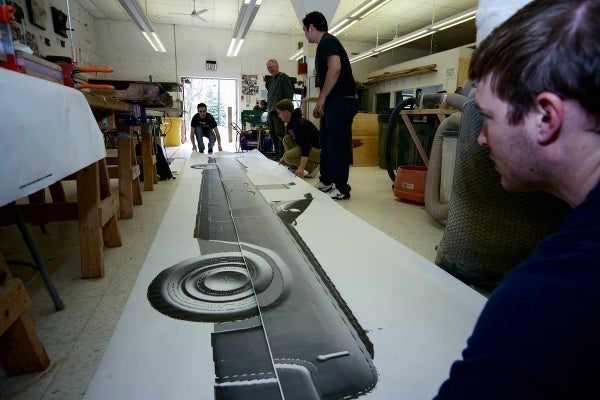Limo model puts visitors where JFK sat during assassination
The single bullet theory, the late U.S. Senator Arlen Specter’s controversial explanation of the John F. Kennedy assassination, will sit at the center of an upcoming exhibit at Philadelphia University in East Falls.
Specter is often credited with developing the theory during his time as a staffer with the Warren Commission, which famously investigated the 1963 assassination.
“Single Bullet: Arlen Specter and the Warren Commission investigation of the JFK assassination,” will give visitors the chance to explore documents and photos from Specter’s personal archives, which he donated to the university in December 2010 as part of its Arlen Specter Center for Public Policy.
The ‘Assassination Room’
The exhibit, the center’s first, will also provide an up-close and personal experience of the assassination itself, both head-on and from a birds-eye view.
To bring the tragedy to life, university students are creating a life-sized, wire-frame of the 1961 Lincoln stretch limo that Kennedy rode in that fateful day in Dallas. It’ll be the centerpiece of what’s being dubbed “The Assassination Room” of the exhibit.
“Obviously, there’s a macabre part of that,” said Dave Kratzer, associate professor of architecture at Philadelphia University, “but it’s hard to understand the nature of the assassination and the conspiracy theories that surround it without trying to put yourself in the place of seeing where the different shooters are coming from.”
Visitors will be able to sit where Kennedy sat as his motorcade rode by Dealey Plaza. There will be no simulated shooting, but cameras will be set up that correspond to the various angles and locations from which conspiracy theorists believe shots were fired.
Various theories
Specter’s theory posited that Kennedy and Texas Gov. Jack Connally were struck by the same bullet, neither fatally, which helped support the Warren Commission’s conclusion that Lee Harvey Oswald was the only one who shot at and killed the president.
Others, including the Select Committee on Assassinations of the U.S. House of Representatives in 1979, have concluded that Oswald fired the shot that killed Kennedy, but that at least one other shooter was taking aim.
“You realize that a lot of [these explanations] are not possible,” said Kratzer. “That was really one of the major points of having the car was to show you that really the most plausible place that the bullets came from was from the snipers perch in the book depository.”
Outside of the 22-foot-long limo, will be a cut-out figure representing Abraham Zapruder, whose private home-video footage of the shooting was used by the Warren Commission. Visitors will be able to watch the silent, color motion video from where Zapruder stood the day of the assassination.
Building the 1963 scene
On a recent afternoon, students in Kratzer’s design-build class were busy sawing, sanding and welding inside a campus fabrication lab off of School House Lane.
On the floor, sat a large 2-D print-out of the Kennedy limo that students are using as a guide for their production work. A similar print displays the front of the vehicle.
“It’s a very graphic moment,” said Taylor Klemm, a fourth-year architecture student who is crafting the backseat of the limo. “So there have been times where we’ve had to be aware of that and maybe dull it down a little bit in terms of how we’re portraying that.”
It’s a project he never imagined he’d be doing, though classmate Robert Garcia said there are some parallels to architecture.
“It’s similar to buildings in the way you design the space, how people walk through and I think that’s a great connection and a great learning experience all around,” said Garcia, whose working on the hood and trunk of the car.
The role of design students
Students from the exhibit design and graphic design programs are also helping to create the exhibit.
Graphic design students will be handling the storytelling aspect of the exhibit that will provide the context for the “Assasination Room” display. That work will include drawings and graphics that depict the different angles and the different locations from which theorists believe the shots may have come from.
That part of the exhibit, which will also feature documents and photos from the Warren Commission’s work, will also contain a model of Dealey Plaza that gives visitors a birds-eye view of the assassination.
“We kind of lost how important in the new generation this event was, so kind of breaking it down to give visitors a new experience from all the levels of what occurred on that day is really important to re-enlightening the visitor,” said Henry Thomas, a fifth-year architecture student who is helping build the model.
For those who were alive during the assassination, like Kratzer, the exhibit is a chance to go back in time.
For those who’ve only read or watched programs about it, such as the students, it’s an opportunity to, in a small way, help bridge that experiential gap.
An ‘unbiased’ view of Specter’s theory
The exhibit, which will be housed in the university’s Paul J. Gutman Library, however, was not created to nudge visitors to agree with Specter’s theory one way or the other. It’ll be up to the individual to draw their own conclusions.
“We wanted to present what we felt was as unbiased a view as possible, but present his viewpoint and what Specter did to investigate and what the evidence was and how he meticulously went through the evidence to draw his conclusions,” said Karen Albert, the library’s director and coordinator of the center.
The exhibit will run from October 2013 through March 2014 to coincide with the 50th Anniversary of the assassination on Nov. 22.
WHYY is your source for fact-based, in-depth journalism and information. As a nonprofit organization, we rely on financial support from readers like you. Please give today.
















